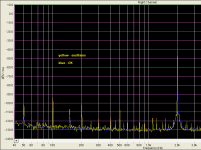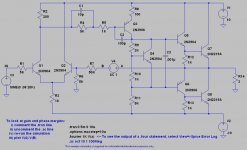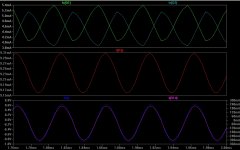PMA, did-you have a square wave trace at 20Kz in this situation ?measurement of 250MHz oscillations in a BJT preamp
Last edited:
Did-you have a square wave trace at 20Kz in this situation ?
Oh yes, I did. It was absolutely perfect! I was unable to find anything with a 100MHz analog scope ...
The only indication was increase of mains components in FFT ... pls see attachment.
Attachments
Bast... I will not be able to sleep now. (smiley here)Oh yes, I did. It was absolutely perfect! I was unable to find anything with a 100MHz analog scope ...
[edit] As i cannot assure there is no such oscillation in my amps, contrary at my previous (wrong) assert.
Last edited:
Oh yes, I did. It was absolutely perfect! I was unable to find anything with a 100MHz analog scope ...
The only indication was increase of mains components in FFT ... pls see attachment.
Yes. Thanks for mentioning the low frequency accompaniment to the VHF parasitic. There is often as well a significant increase in inband noise, a sort of downconversion.
I think I related a long story elsewhere about the department chair having trouble with his Heathkit receiver, circa 1970, which he and sons had spent weekends assembling. It worked fine except for excess noise on a line level input, which made no sense to the eminent astronomer, who expected it would be the phono input if anything were to be audibly noisy.
I looked at the schematic and noticed a bootstrapped emitter follower, in fashion those days, and conjectured that Heath had developed the circuit with fairly low-Ft parts, and as transistors had improved not checked carefully about stability when sourcing new stock. I gave George a certain-to-be-slow part and told him to change it out. I could see he was dubious. And it was a great deal of work to disassemble the unit (remember stringing tuner dial cords?).
He returned and told a long story of the arduous effort leading up to the outcome, which he revealed at the end. It had worked, the input was now silent. My stock rose significantly from this experience.
Bast... I will not be able to sleep now. (smiley here)
[edit] As i cannot assure there is no such oscillation in my amps, contrary at my previous (wrong) assert.
You may sleep well 😉. The 1st indication was purely sonic, by listening. When oscillating, a low-level buzz from speakers was audible and there was a loss of 'space' information. Then I started to measure and finished with Agilent UHF analyzer measurement, that revealed the problem entirely.
In one of the few Abso!ute Sound articles of the day with technical details, Bascom King reviewed a big Jadis tube amp and loved the sound. He was at a loss to explain it, speculating among other things that hollow-state rectification seemed to be associated with good results from tubes. And on top of it all, when he did do some measurements he saw little puffballs of oscillation riding on square waves! Horrors!Bast... I will not be able to sleep now. (smiley here)
[edit] As i cannot assure there is no such oscillation in my amps, contrary at my previous (wrong) assert.
Yes. Thanks for mentioning the low frequency accompaniment to the VHF parasitic. There is often as well a significant increase in inband noise, a sort of downconversion.
Thank you. In this case, THD remained unaffected and in-band noise had not increase, but I have another examples where an in-band noise had increased, or THD had risen.
Typical. Thanks a lot for sharing this experience.a low-level buzz from speakers was audible.
Sometimes, in this thread, there is an index pointed in an useful direction. For me, this was one of them.
In one of the few Abso!ute Sound articles of the day with technical details, Bascom King reviewed a big Jadis tube amp and loved the sound. He was at a loss to explain it, speculating among other things that hollow-state rectification seemed to be associated with good results from tubes. And on top of it all, when he did do some measurements he saw little puffballs of oscillation riding on square waves! Horrors!
It was semi-class D amp. So what? 🙂
Scott, I hope you would not mind if I post a measurement of 250MHz oscillations in a BJT preamp ...
Who would take a bet that no one out there is perfectly happy listening to an audiophile amp or preamp that is happily oscillating at 10's or 100's of MHz?
Since I have already witnessed an amplifier get a high rating in TAS while RF oscillating I know the answer.
I would bet a fair amount of DIY has RF and it sounds fantastic to the builder.😉
Not acceptable to the pro though. One thing AP test gear does is it usually shows the oscillation as a down converted signal especially while auto ranging and sweeping. Better than my old 339 at that kind of thing but no sub for the 2 GHz spectrum.
Not acceptable to the pro though. One thing AP test gear does is it usually shows the oscillation as a down converted signal especially while auto ranging and sweeping. Better than my old 339 at that kind of thing but no sub for the 2 GHz spectrum.
It was semi-class D amp. So what? 🙂
At least it didn't melt down during the evaluation, as, iirc, they were prone to do 🙂
Hence "Burning Amp" festival. 🙂At least it didn't melt down during the evaluation, as, iirc, they were prone to do 🙂
An old radio ham Zen koan: What does an amplifier do, and an oscillator does not?
Oscillate!
Thanks,
Chris
Oscillate!
Thanks,
Chris
Yes Chris. This is one of the examples of the restricted Murphy law.An old radio ham Zen koan: What does an amplifier do, and an oscillator does not?
Oscillate!
The extended one says: Most of the time, the exceptions are just there to keep working the effect of surprise.
Last edited:
Sometimes amps with PFB are more stable than amps with NFB: look at Scott Wurcer's opamps, some of them have something reminding Schmidt trigger causing uneasiness upon the first look. 😀
George, thanks for the excellent set of Baxandall papers.
You’ve rung that bell Pavel 🙂
By the way, part 4 is on time with the HF oscillations twist, although it all started here: http://www.alcatel-lucent.com/bstj/vol11-1932/articles/bstj11-1-126.pdf
You may sleep well
… and there was a loss of 'space' information.
I keep some Valium pills nearby ‘cause I have experienced an increase of “space” information in one case ( and I was sober 😀 ).
George
Okay, had a simplistic play with the "educational" audio amp circuit that comes with an installation of LTspice to see what happens when the FB circuit is stressed: this was done by dropping the load resistor from 8 to 3 ohms, and feeding it a 20k sine at an input level such that the output stage is still well below clipping. Of course, this is a very basic circuit but it does work as an amplifier comparable to a lot of stuff out there. The output waveforms are not brilliant but look reasonable enough.You won't hear the oscillations, but if the circuit is misbehaving in that fashion then the chances are that it can't be functioning as intended in the audio region; again, especially as far as the FB mechanism is concerned. It seems as if I'll have to play with LTspice, deliberately simulating non-linear behaviour in the output, to see what signal frequencies the FB area of the circuit is experiencing ...
Frank
But, note the the current waveforms of the collectors of the differential input pair, Ic(Q1) and Ic(Q2), the FB having to cope with correcting crossover distortion; these are starting to look very nasty, meaning high frequency components, well above audio, are now present within the circuit, and are demanding that the power supply respond. If there are instabilities anywhere in the circuit then this very likely will trigger oscillation ...
Frank
Attachments
yes you could "prove" feedback "problems" with a toy circuit showing obvious crosover distoriton
or you could find sims with hand tweaked transistor models in the Cordell threads with 100 mA+/output Q Mosfet or bidpolar amps...
or you could find sims with hand tweaked transistor models in the Cordell threads with 100 mA+/output Q Mosfet or bidpolar amps...
Okay, had a simplistic play with the "educational" audio amp circuit that comes with an installation of LTspice to see what happens when the FB circuit is stressed:...
Frank
I agree when will people finally accept the uA741 does not work for audio and stop showing why?
- Status
- Not open for further replies.
- Home
- Member Areas
- The Lounge
- John Curl's Blowtorch preamplifier part II


